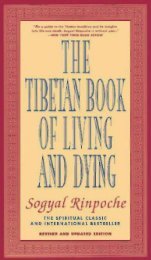Mandukya_Upanishad
Mandukya_Upanishad
Mandukya_Upanishad
Create successful ePaper yourself
Turn your PDF publications into a flip-book with our unique Google optimized e-Paper software.
in the present, all that will be in the future, all this is Om,because Om has no past, present and future; the Universalhas no time. What a grand description of Om is given in theMāndūkya <strong>Upanishad</strong>! Whatever is in time, as past, presentand future, is Om. Not merely this; that which is abovetime, also, is Om. Om has a twofold nature, the temporaland the eternal: it is śabda and śabdātita. It is constituted ofA, U, M, representing all creation; but it has also a fourthnature which transcends these distinctions of A, U, M. It iscalled amātra and chaturtha-bhāva: The soundless form ofOm is amātra, the immeasurable, and it is not audible tothe ears. This amātra, or the immeasurable, eternal natureof Om is not a sound or even a mere vibration, but it is justexistence, pure and simple, known as satchidānandasvarūpa– Existence-Consciousness-Bliss.That which is past, present and future is the temporalcomprehension of the gamut of Om, and that whichtranscends time is the eternal nature of Om. To give theanalogy of the river and the ocean: the river is the temporalform, the ocean is the permanent form. There is a nameand a form for the river, but there is no such name andform of the river in the ocean, as all rivers become one inthe ocean. In the temporal form, Om may be said todesignate all that is existent in creation; in its eternal form itcannot be said to constitute any kind of particular form, butit is formless, durationless and spaceless. Om, therefore, isname and form; form and the formless; vibration andConsciousness; creation and satchidānanda. All this is Om.How to chant Om? This doubt may arise in your mind.We have tried to understand something about the26



